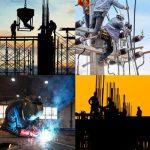Working with scaffolding can be precarious for many people; you need to overcome your fear of heights and of wide open spaces. Not many are cut out for work on buildings or outside of buildings and those that do this type of work need to be very careful.
Any individual or employer whose business includes working on scaffolding should understand the importance of safety; this is no time to even joke about falling or having the structure collapse around this person. And there are many aspects to this type of work other than just climbing up and doing your work. There are usually many safety processes in place for those that work on scaffolding and they all need to be considered carefully.
These reminders are important if the work you’re doing is a few feet off the ground or a few hundred feet in the air. Working with increased heights can be manageable and completely safe, if workers remember a few simple tips.
Level and Locked
Because scaffolding is a temporary structure, it needs to be locked in place. It also needs to be level so as to prevent slipping. It is imperative that there be a safety checklist for anyone working with these structures and that it be checked for being level and locked before anyone starts working.
If you’re using scaffolding on uneven ground, there is typically a way to make it level without trying to “jimmy” it or use homemade solutions. Remember that this is not a coffee table under which you can slide a matchbook to make it level! So secure it in place and be sure it’s level as well.
Safety Around the Structure
There are many safety features and processes around the scaffolding that should be followed. For example, there should be sufficient planking around the bars and on the ground part of it, with gaps no larger than one inch. There are also needs to be a safe way to get onto and off of the structure, such as a ladder that is also secure. No one should treat the structure as monkey bars that can be climbed.
The scaffolding should also be fully clear of electrical outlets and cords. This too is important because cords can wrap around the base of it and cause it to tip. Electrical current can also be carried by the tubing.
There is also need for safety precautions around the scaffolding and underneath it. Equipment needs to be secured to the tubing and those working around and under it should be wearing hardhats. There have been many injuries on jobsites due to equipment falling from these structures and hitting those working below. Everyone should use caution when working around these and should be wearing proper safety equipment especially hardhats.
If you remember these few simple tips you will have fewer accidents and injuries on your jobsite. Remember that scaffolding can be dangerous to those working on it and those working around it, so safety is key!
Working with scaffolding can be precarious for many people; you need to overcome your fear of heights and of wide open spaces. Not many are cut out for work on buildings or outside of buildings and those that do this type of work need to be very careful.Any individual or employer whose business includes working on scaffolding should understand the importance of safety; this is no time to even joke about falling or having the structure collapse around this person. And there are many aspects to this type of work other than just climbing up and doing your work. There are usually many safety processes in place for those that work on scaffolding and they all need to be considered carefully.
These reminders are important if the work you’re doing is a few feet off the ground or a few hundred feet in the air. Working with increased heights can be manageable and completely safe, if workers remember a few simple tips.
Level and Locked
Because scaffolding is a temporary structure, it needs to be locked in place. It also needs to be level so as to prevent slipping. It is imperative that there be a safety checklist for anyone working with these structures and that it be checked for being level and locked before anyone starts working.
If you’re using scaffolding on uneven ground, there is typically a way to make it level without trying to “jimmy” it or use homemade solutions. Remember that this is not a coffee table under which you can slide a matchbook to make it level! So secure it in place and be sure it’s level as well.
Safety Around the Structure
There are many safety features and processes around the scaffolding that should be followed. For example, there should be sufficient planking around the bars and on the ground part of it, with gaps no larger than one inch. There are also needs to be a safe way to get onto and off of the structure, such as a ladder that is also secure. No one should treat the structure as monkey bars that can be climbed.
The scaffolding should also be fully clear of electrical outlets and cords. This too is important because cords can wrap around the base of it and cause it to tip. Electrical current can also be carried by the tubing.
There is also need for safety precautions around the scaffolding and underneath it. Equipment needs to be secured to the tubing and those working around and under it should be wearing hardhats. There have been many injuries on jobsites due to equipment falling from these structures and hitting those working below. Everyone should use caution when working around these and should be wearing proper safety equipment especially hardhats.
If you remember these few simple tips you will have fewer accidents and injuries on your jobsite. Remember that scaffolding can be dangerous to those working on it and those working around it, so safety is key!





